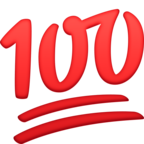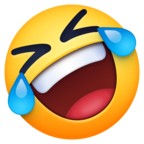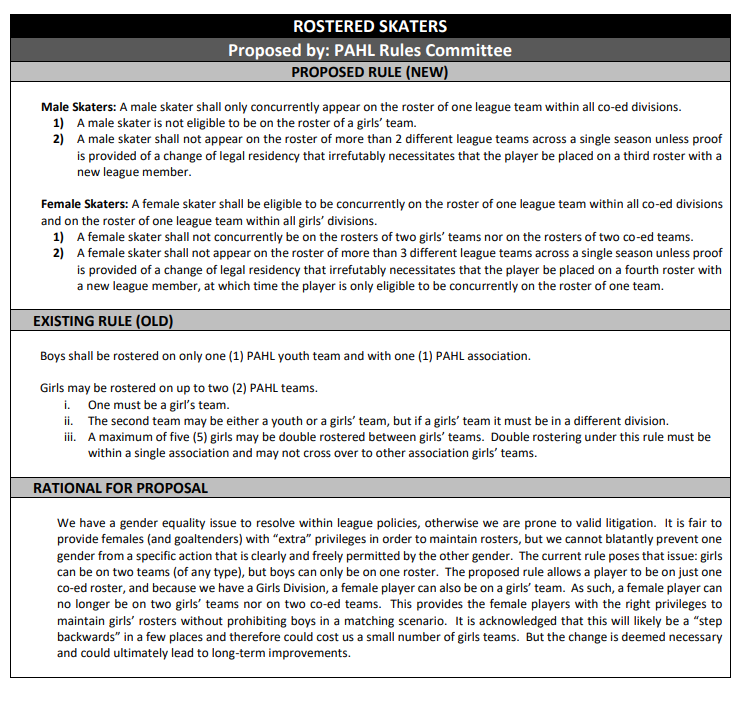
James Gatz
Members-
Posts
59 -
Joined
-
Last visited
-
Days Won
5
Content Type
Profiles
Forums
Events
Everything posted by James Gatz
-
There are plenty of ways the tryout season could work. The current model is basically a free agency free for all. I am not sure that's not the best. It let's the kids play where they want to play and lets organizations build teams. Players have to be selective with where they tryout and have commitment fees at stake if they want to play the field. The system isn't perfect, but it works. Thinking through potential alternatives each have their own issues. The independent teams add a layer of complexity, for a league like the PAHL, they could have some league rules tryouts/offers. (of course those rules would have to approved by organizations, who are not likely to vote against their interest). Option 1--An offer clearinghouse. It could work like residency placements for doctors. Players tryout at different places. Players and organizations submit priority list to the clearinghouse and the clearinghouse matches players with teams. Players have no choice but to play for that team. Does anyone really want this and trust the clearinghouse? Talk about taking away a coaches role in building a team. Option 2--Impose geographical boundaries on team formations. Any takers? Option 3--Schedule tryouts so there are few overlaps and require organizations to keep offers open until league-wide commitment date. No organization would vote for this and it likely would lead to lots of supplementals. I'm sure there are other approaches, but I can't think of any that improve on the current approach. The current approach maximizes the individual player's freedom of choice. Some of those choices have consequences...
-
Look no further than Michael Bunting as a shining example. Never played AAA Midget until his final year of eligibility.
-
@zam hits on an important point, and that's that parents of "tenured" AAA players are not always accepting of new additions if they were historically AA/PAHL players. An established AAA team loses a couple players for whatever reason. As they replace them, other returning families assume there will be a drop-off and then one or two more pull out. At some point there is a run on the bank as more leave what they see as a sinking ship to find a chair somewhere else before the music stops. Its not necessarily that there are not customers, it is sometimes that existing/returning customers, don't accept change.
-
Vengeance Tier 2 turnout?
James Gatz replied to nemesis8679's topic in Western Pennsylvania Youth Hockey
But in the Mighty Ducks TV series, they seemed to do away with districting and went with a tryout model where kids that enrolled in camps and private lessons had a leg up on making the Ducks. A few of us could benefit from listening to the speech about the "the stakes could not be lower" from the first episode of the TV series. -
Paid coaches, skills/goalie training, dryland, 12-15 summer practices, 2-3 weekly practices in season, 50-55 game schedule, 4-6 showcases, HUDL video, nicer locker room for Frozen Pond, THF schedule, feeling of superiority over Tier 2 Icemen and Yetis.
-
I am having a hard time thinking of any organization around here with more than 3-4 travel teams per age group. The deepest programs can, and should, field multiple 10U teams. The numbers thin as in the upper age groups through attrition. very few programs are big enough to have a robust house program. I don’t see that many problems with local travel. The trend towards AHF/non-local travel at the youngest age groups is worth discussing, but even those organizations doing this have no more than one team per birth year.
-
Goalie development is unique and lonely journey. I am a big proponent of supplementing with private lessons. There are a handful of people out there offering private goalie instruction in all four cardinal directions from downtown. Some of the organizations also offer 2x/month goalie clinics. They are okay, but not as useful as private lessons from my experience. When it comes down to the individual teams, much less the different organizations, your mileage will vary greatly when it comes to what the coaching staff knows and does when it comes to goalie coaching. Some do provide coaching during practice and others provide virtually zero instruction. It is a position where the kid has to be a self-motivated, dedicated individual to coach themselves a fair amount. It can be a struggle to apply what you learn in private lessons/clinics to practice and a battle to reinforce good habits vs. forgetting all they learned in the lessons/clinics. I don't think there is any one organizatoin that does it best; the individual team/coaching staff matter most.
-
Cost of SCIR/Vengeance Tier 2 Tuition?
James Gatz replied to PittsburghHockeyFan's topic in Western Pennsylvania Youth Hockey
And for most of PAHL organizations I've looked at, their advertised costs disclose that the numbers of tournaments played are decided by the individual teams and the costs for those are extra. The advertised price generally just covers practice and the PAHL schedule. -
I think you are right. The main problem with manager input was the FPP screw-ups. Eliminate that and restore the manager input. Problem solved.
-
I don't even know if this is correct this year. For at least the level I follow, everyone's game count stopped in late December/Early January. That's not even being input any more.
-
The scorekeeping is going to be inconsistent. It is dependent on largely untrained, parent volunteers serving as the scorekeeper. It is probably worse at the younger age groups where some of the parents, like the players, are new to the sport and the role. Everyone should be willing to accept this and know the stats are not the be all end all. Not posting the stats, however, does beg the question of why keep them at all? Why not just report the final scores and penalty minutes and move on? The answer lies in that the leauge does keep and use the stats. I suspect they are useful in making placement decisions in subsequent seasons. If the league is going to keep the stats, and use them internally, what is the real harm in publishing them? I've seen two theories put forth and address each below: 1.) Post-game parent complaints. The PAHL could adopt a rule/policy position along the final lines and post it on their site. "All scoring is final once signed by the appropriate officials and submitted to the league office. The PAHL will not hear any appeals regarding scoresheets....." 2.) Other teams leagues will use public scoring to poach/recruit. Who cares. It's a small community here and for the most part people know who is who. Frankly, the managers, coaches, and member organizations have the scoresheets and could use them for recruiting purposes already. Not publishing the scores is not the best way to govern recruiting issues.
-
The Frozen Pond/Icemen are moving younger age groups towards the AHF as well. Looks like they intend to field AHF/Icemen teams from first year squirts up. Time will tell how many PAHL teams the Yetis are able to field.
-
Why should the PAHL care about how the athletes prioritize their time? I can see why people might care at an organizational or team level, but what concern is it of the league? If you buy my premise that the league shouldn't care, the next question is why are they trying to legislate this at all? I get if organizations want to have some internal rules/expectations, they can, but the organizations also have some control over scheduling. For the double-rostered, we are talking about a handful of players in each organization and the managers of the two effected teams should be able to coordinate scheduling. For the other rule banning Tier 1 players from playing on PAHL, the devil is in the details of defining a Tier 1 team. On some level it makes sense for PAHL to define itself as a B-AA league, so excluding true Tier 1 athletes, regardless of gender, makes sense. Saying that the second 10 girls PPE team is a Tier 1 team, however, is not consistent with everyone's definition of Tier 1.
-
One way to mitigate the double rostering litigation risk without gutting organizations ability to field multiple girls division teams would be to make all players eligible to double-roster under the old rule for girls? The old rule includes the limitation that "A maximum of five (5) girls may be double rostered between girls’ teams. Double rostering under this rule must be within a single association and may not cross over to other association girls’ teams." The old rule says that double rostering within the girls division, the second team must be in a different division. Remove the gender limits and allow organizations 5 double-roster spots to be use however they want. So, if an associated is limited to just 5 double-rosterings, there won't be a deluge of boys doubling up. The organizations would have to chose how to use those spots. Most would likely be used by girls in those organizations fielding girls teams. Under this tweak, girls would lose the ability to roster on both a youth and girls team within an age group, but they could still play up an age group. This approach would mitigate the litigation risk, while still allowing 5 girls to double roster. The expense would be that girls could no longer play co-ed at their age group and on a girls team. A second cost would be that some organizations might chose to use their 5 spots to allow their favorite boys to double-roster and play up.
-
There are two proposed rule changes related to roster limitations girls. Both cite litigation fears as a rationale for the rule change. This is the second.
-
There is a reference in the proposed rules to evaluating the curfew protocol. No real details given.
-
This does seem counter-productive. They say it is to avoid potential litigation. That fear may be overstated, but wouldn't a better approach be to make all players eligible to double-roster under the old rule for girls? The old rule includes the limitation that "A maximum of five (5) girls may be double rostered between girls’ teams. Double rostering under this rule must be within a single association and may not cross over to other association girls’ teams." So, if an associated is limited to just 5 double-rosterings, there won't be a deluge of boys doubling up. The organizations would have to chose how to use those spots. Most would likely be used by girls in those organizations fielding girls teams, but if the opportunity were open to all, they could minimize the litigation risk.
-
Looks as if PAHL may be re-evaluating the Fair Play Point system. There is info on some of the new rules proposals on their site. PAHL Playing Rules Proposals (pahockey.com) The proposed new rule for goalie rostering seems complicated. It looks like they are considering limiting a goalie's ability to skate out to 25% of the games. I suspect this is a non-issue for most of the older age groups. For Squirts, why 25% and not 50%?
-
Speaking of the next meeting, anyone have any information on the rules changes they will be discussing as related to rostering? From the Pulse newsletter, "So the Committee has identified a few rules proposals that would need to be discussed prior to tryouts if they are to be implemented for the 2024-25 season, primarily related to eligibility and the composition of team rosters. Those proposals will be presented at the February 20th membership meeting."
-
What is happening at ALPHA ICE?
James Gatz replied to IceMom's topic in Western Pennsylvania Youth Hockey
It is interesting that they are going all-in on a single branded youth amateur hockey organization. Other programs are creeping in this direction but haven't gone all-in. The Yetis/Icemen are an example. PHA/Frozen Pond is expanding the Icemen brand to include Independent birth year Squirt teams. They will keep the Yetis brand for PAHL teams. As much as those organizations are linked when convenient, tryouts and registration will stay separate, so presumably you will have to pay two tryout fees if you don't make the Icemen but want to tryout later for the Yetis. -
It will be interesting to see if the Aviators have the ice time and/or desire to grow the Aviators or if it will stay as a smaller niche organization targeting AA players. Presently, there is no Aviators mite program. I have heard that is one of the goals moving to SSA is that they will have an ADM program with Tangradi leading it. This year (2023/2024) the Aviators have the following PAHL teams: U10 (2013)--AA U12 (2012)--A Major Black U12 (2011)--AA U14----A Major Gold U14 (2010)--A Major Black (I might have some of the 14 U teams mixed up) U14 (2010)--AA U14 (2009)--AA U16--A Major Gold
-
What is happening at ALPHA ICE?
James Gatz replied to IceMom's topic in Western Pennsylvania Youth Hockey
In keeping with thread title, is it true that in addition to not renewing the Aviators, Alpha has informed the Vipers that they will not get ice next year too? Not sure where that leaves the Vipers. The Vengence/Renegades will be the only option at Alpha next year. -
What is happening at ALPHA ICE?
James Gatz replied to IceMom's topic in Western Pennsylvania Youth Hockey
There are plenty of parents I've spoken too who are not taken in by AAA mystique and want to find places for their kids to play an honest PAHL schedule. It is not their naivety or vicarious living preventing them from pushing back as much as it is lack of options. I don't know what they are supposed to do to push back other than to vote with their wallets, but there seem to be fewer options in the market for these parents than a few years ago. -
What is happening at ALPHA ICE?
James Gatz replied to IceMom's topic in Western Pennsylvania Youth Hockey
I can't vouch for the accuracy of this, but the explanation I heard was that Vengeance is a for profit organization that historically competed as an independent. Renegades was a non-profit which competed primarily in the PAHL. Now that the PAHL bylaws permit for profit teams to participate, Vengeance is anticipating expanding and fielding some PAHL teams. Not sure if Renegades will continue more or less as they are constituted as a lower-commitment option to feed the Vengeance. I have also heard that Aviators are moving to Shadyside and that some of the SSA coaches will have skills coaching roles with the Aviators. -
I've been that moron, but looked it up after the game and learned something.




